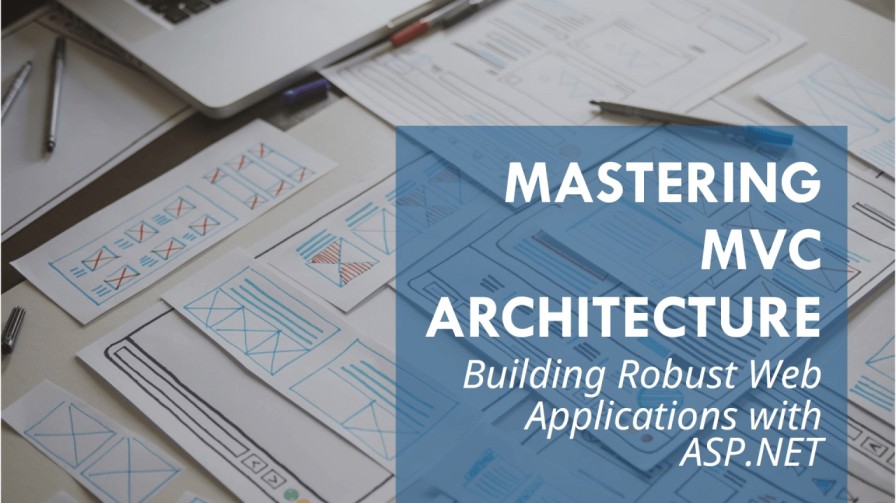MVC (Model-View-Controller) is a software architectural pattern that separates an application into three main components: Model, View, and Controller. ASP.NET, a popular web application framework developed by Microsoft, leverages this architecture to build scalable, maintainable, and testable web applications. In this article, we’ll dive deep into the MVC architecture, how it works in ASP.NET, and why it is a go-to pattern for developers.
What is MVC Architecture?
The Model-View-Controller architecture divides an application into three interconnected components:
Model:
The Model represents the application’s data and business logic. It directly manages the data, logic, and rules of the application. In an ASP.NET MVC application, the Model typically interacts with the database and defines how the data should be handled.
View:
The View is responsible for presenting data to the user. It displays the data from the Model and sends user input back to the Controller. In ASP.NET, the View is usually represented by Razor Pages or HTML markup, which dynamically render the content based on the data from the Model.
Controller:
The Controller acts as an intermediary between the Model and the View. It handles incoming user requests, processes them (by interacting with the Model if necessary), and determines which View should be rendered. In ASP.NET MVC, Controllers are C# classes that handle the business logic and manage the flow of data.
How MVC Works in ASP.NET
In an ASP.NET MVC application, the request/response life cycle follows a clear pattern:
Routing:
When a user sends a request, it is first processed by the ASP.NET routing engine. The routing system maps the incoming request to the appropriate Controller and action method.
Controller:
The Controller receives the request and determines what actions need to be taken. It may retrieve or update data using the Model.
Model:
The Model contains the logic to fetch, update, or process data. The Controller interacts with the Model to get the necessary data for the View.
View:
After the Controller has processed the data, it selects a View to render. The View uses the data passed by the Controller to generate an output, usually an HTML page, which is then sent back to the user.
Response:
The generated View is sent back to the user as an HTTP response.
This separation of concerns ensures that each component is independent and focused on its responsibilities, resulting in cleaner, more maintainable code.
Key Components of ASP.NET MVC
Models in ASP.NET MVC
Models are classes that represent the data and business logic of the application. They are responsible for interacting with the database, applying validation, and performing business rules. In ASP.NET MVC, models can be created using plain C# classes, and they can also leverage Entity Framework for database operations.
Example of a simple Model:
public class Product {
public int Id { get; set; }
public string Name { get; set; }
public decimal Price { get; set; }
}Views in ASP.NET MVC
Views are responsible for presenting the data to the user. In ASP.NET MVC, Views are typically Razor pages (.cshtml files) that combine HTML and C# code. Razor syntax allows for dynamic content generation while maintaining a clean and readable structure.
Controllers in ASP.NET MVC
Controllers are classes that handle user input and interactions. They receive incoming HTTP requests, process them, and determine which View should be displayed. Each action method in a Controller corresponds to a specific endpoint.
Advantages of MVC Architecture in ASP.NET
1. Separation of Concerns:
The MVC pattern separates the application into distinct sections, making it easier to manage, develop, and test. The business logic (Model), user interface (View), and input logic (Controller) are all independent, allowing developers to work on different parts of the application simultaneously without causing conflicts.
2. Testability:
The separation of components makes it easier to write unit tests for each part of the application. Controllers can be tested independently without relying on the user interface, making the application more reliable.
3. Scalability and Maintainability:
MVC applications are easier to scale and maintain over time. As the application grows, new features can be added without disrupting existing functionality.
4. Extensibility:
The MVC framework in ASP.NET is highly extensible. Developers can customize and extend almost every aspect of the framework, including routing, filters, and dependency injection.
5. Better Control Over HTML and URLs:
ASP.NET MVC gives developers full control over rendered HTML and URLs, which is essential for building SEO-friendly applications.
MVC in ASP.NET vs. WebForms
Before ASP.NET MVC, many developers used ASP.NET WebForms, which follows a more event-driven approach. While WebForms are easier to learn for beginners, they hide much of the complexity of HTTP and the web, leading to less control over HTML and URLs. In contrast, MVC exposes the underlying web protocols, giving developers more control and flexibility, making it a better choice for modern web applications.
Conclusion
ASP.NET MVC provides a powerful and flexible framework for building web applications with a clear separation of concerns. By understanding and leveraging the Model-View-Controller pattern, developers can create scalable, maintainable, and testable applications. Whether you’re building a simple website or a complex web application, ASP.NET MVC offers the tools and structure to make your project successful.
For anyone starting out or transitioning from older frameworks, MVC is an architecture that not only simplifies asp net web development but also lays the foundation for more modern and scalable applications.

